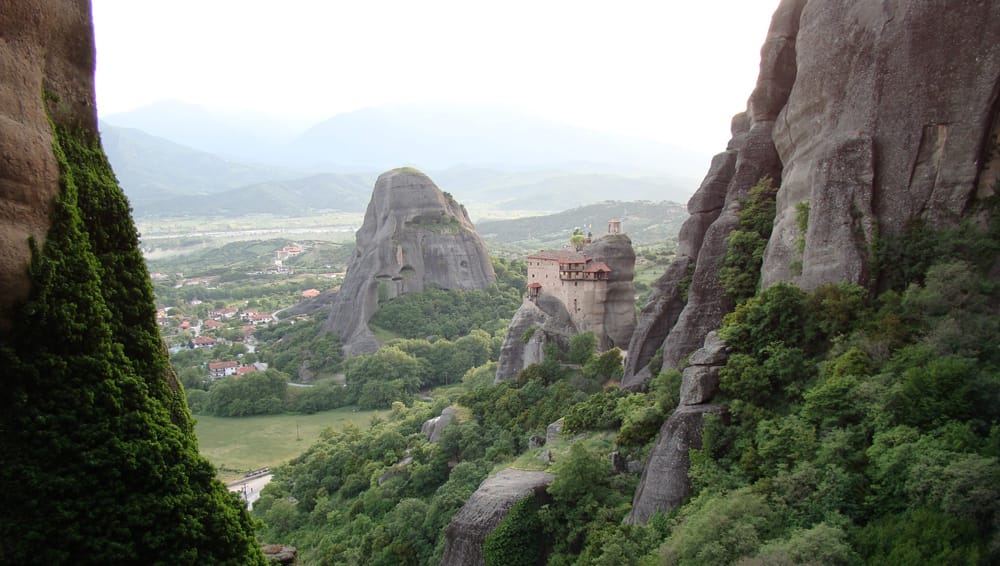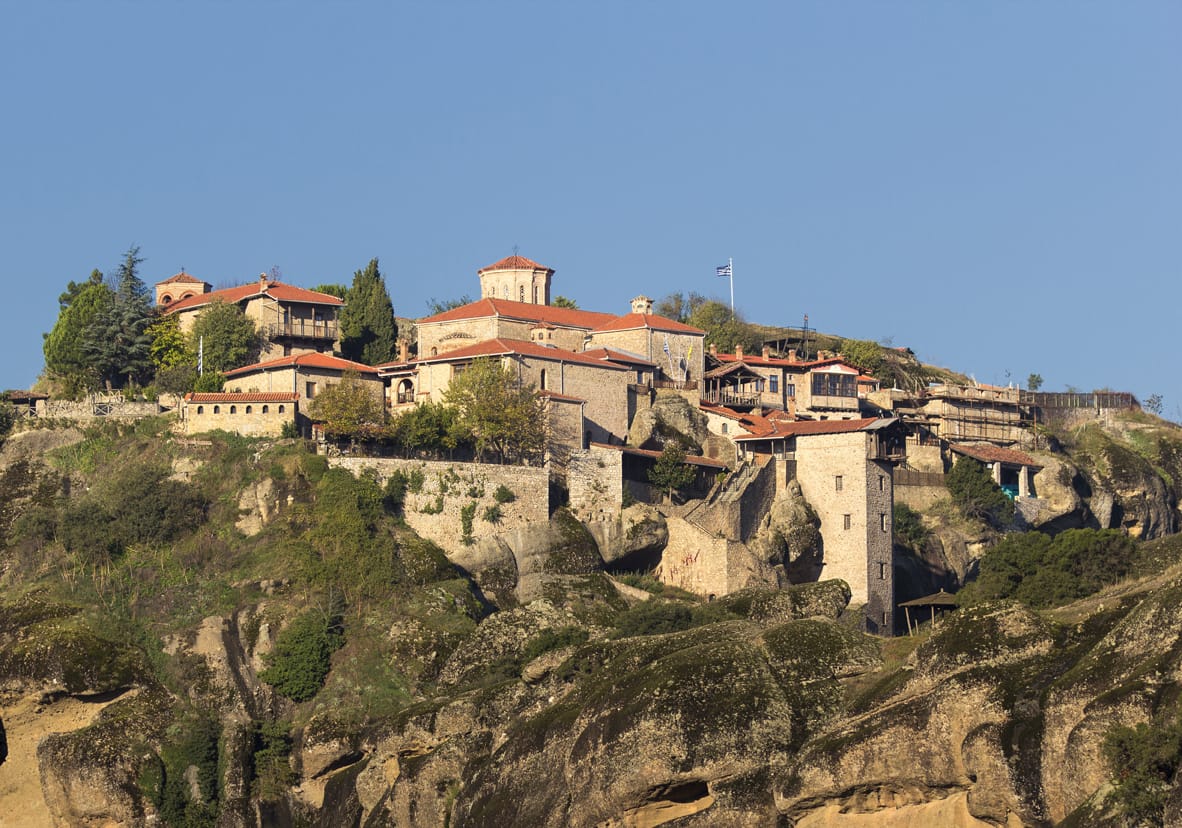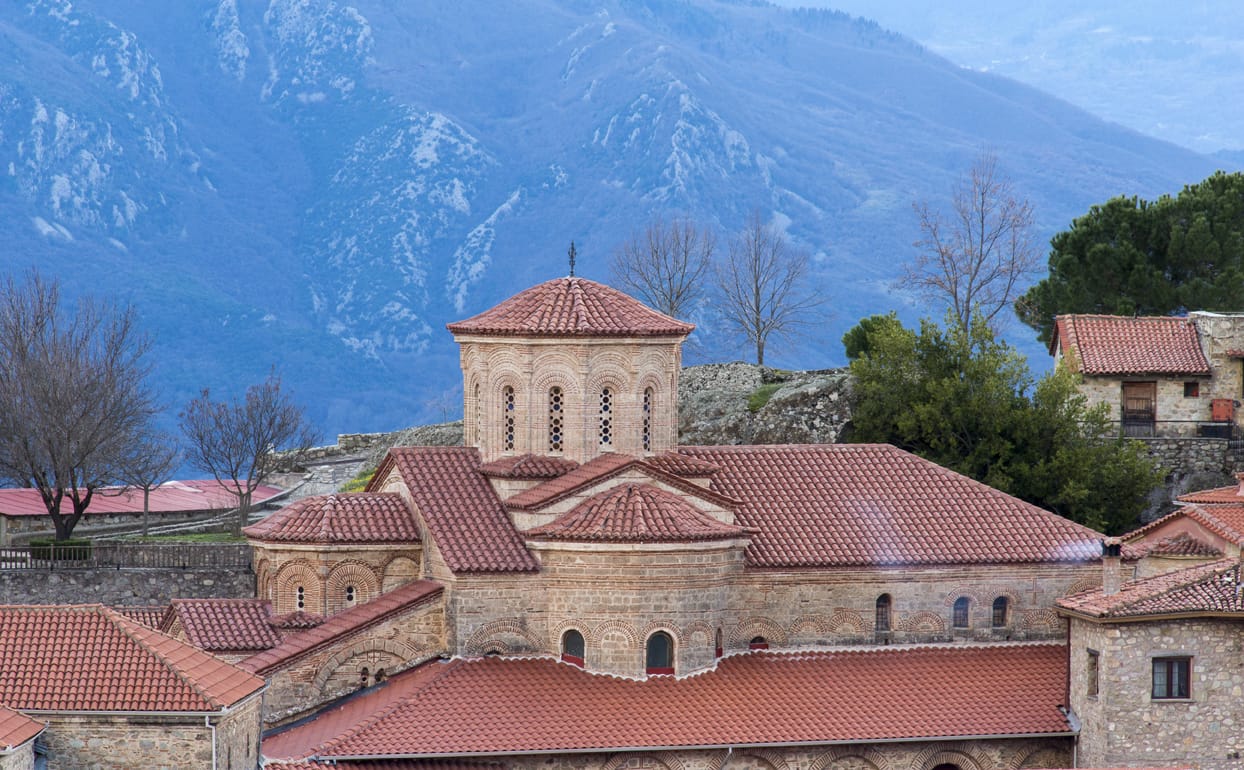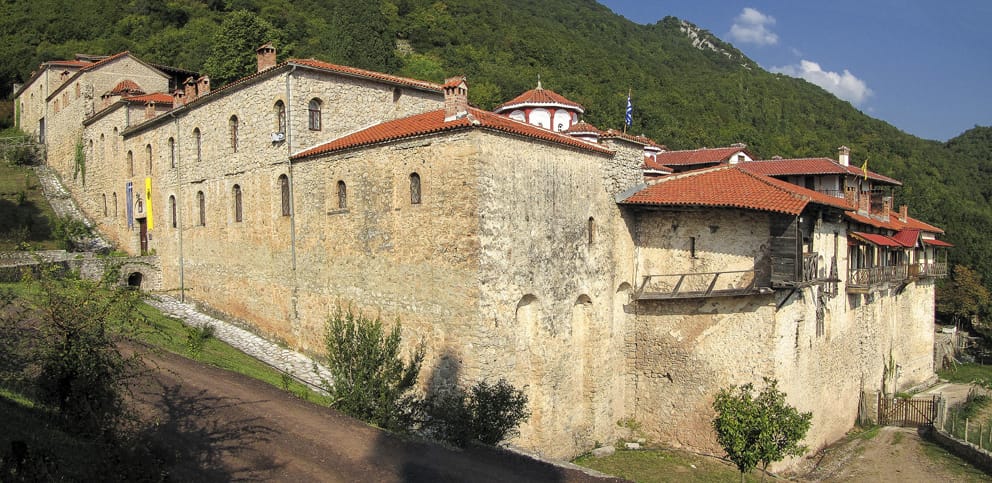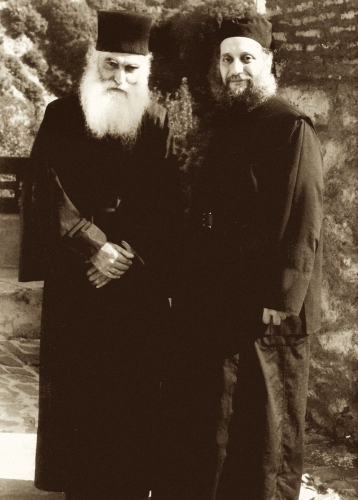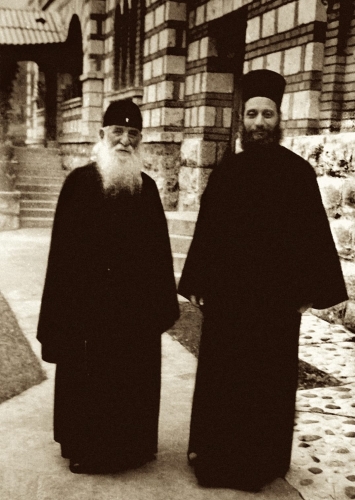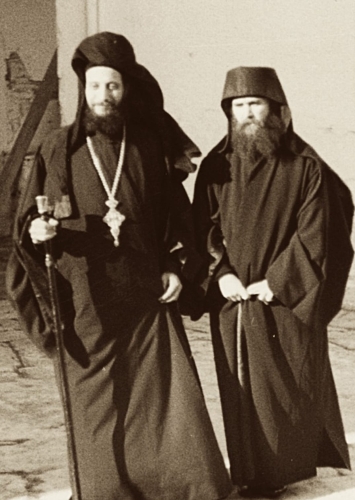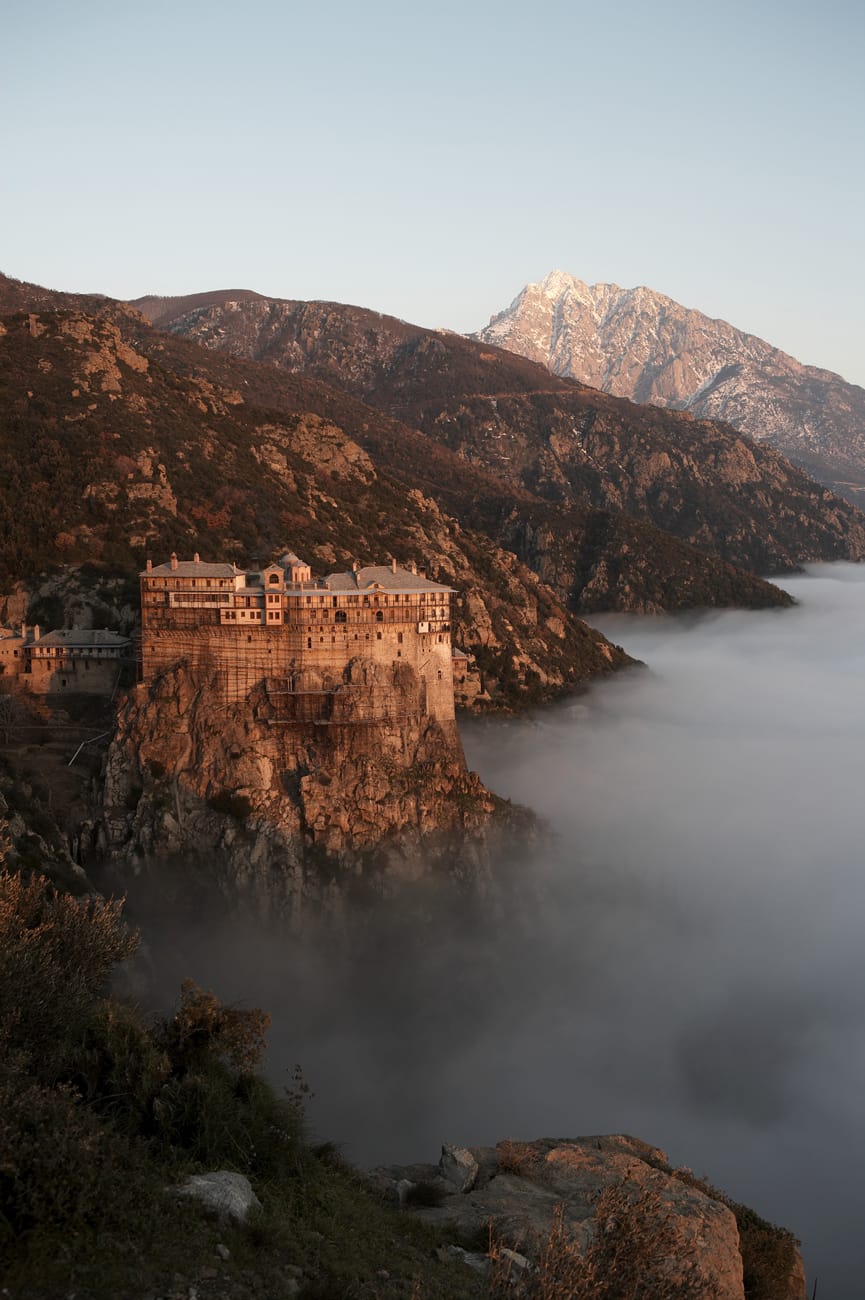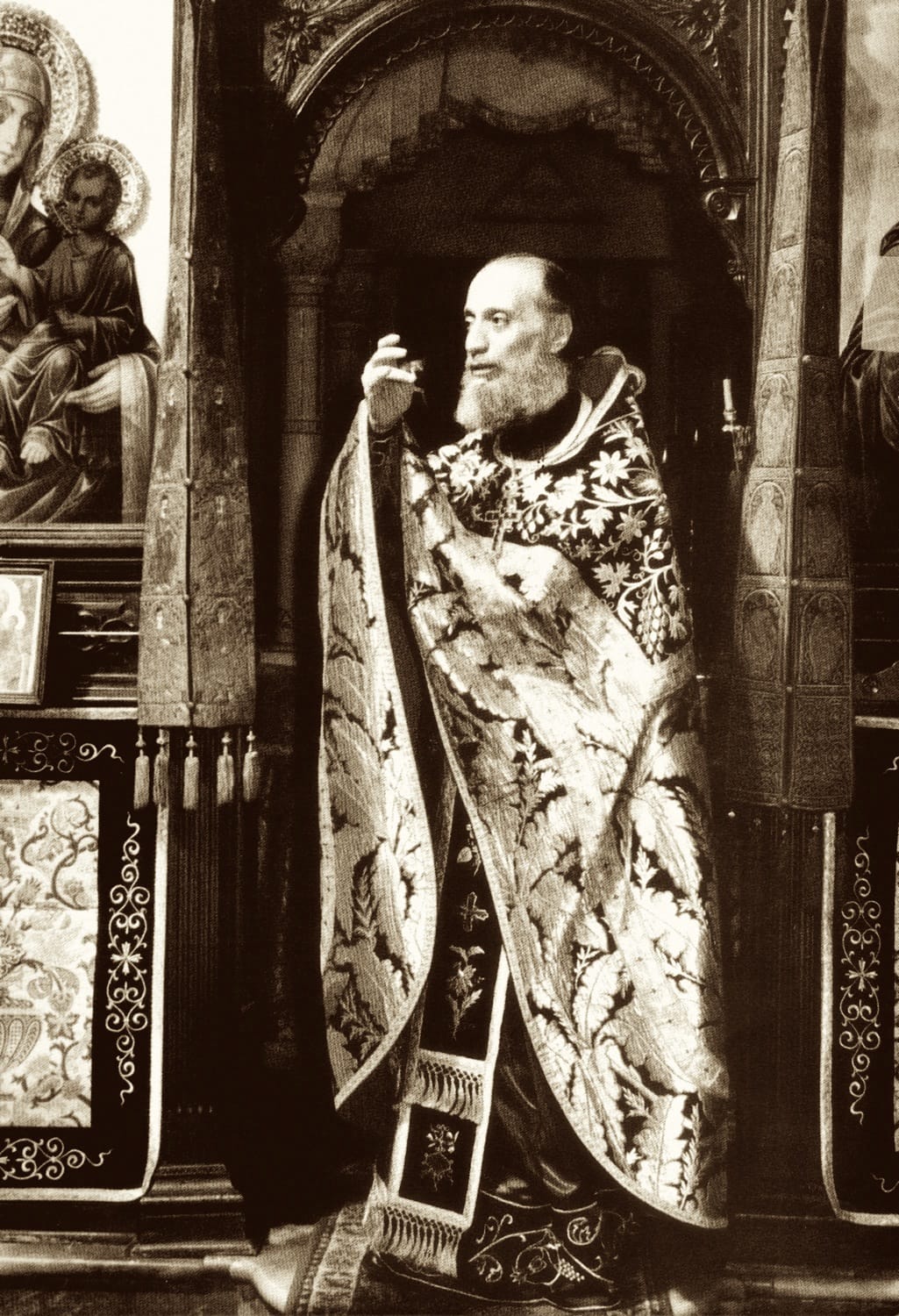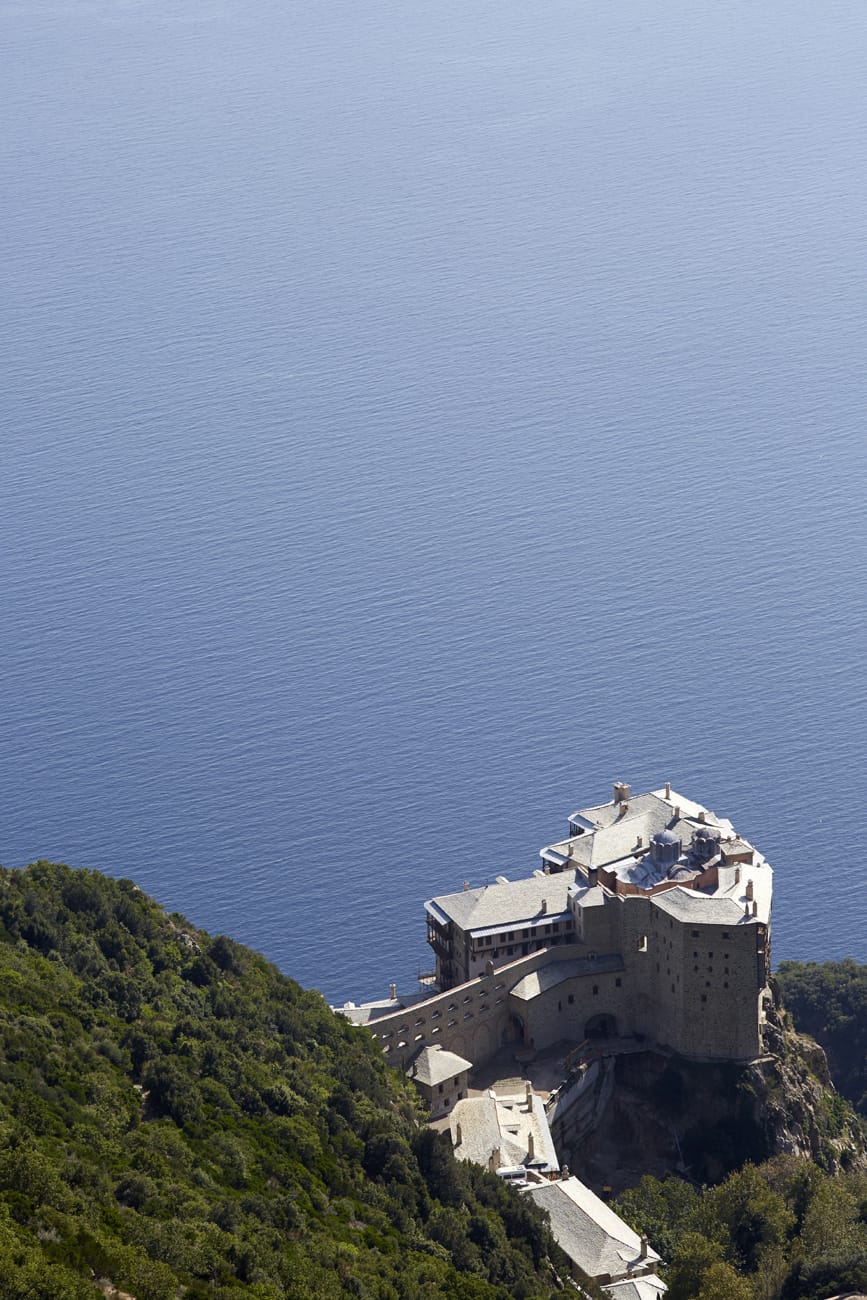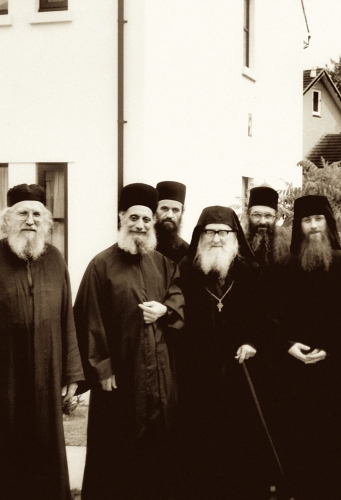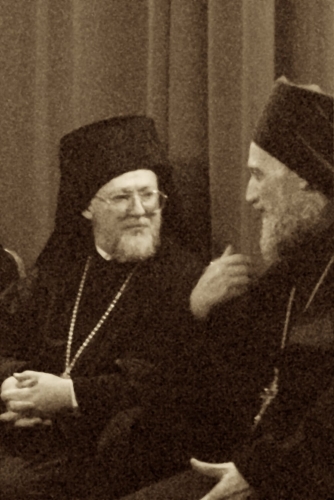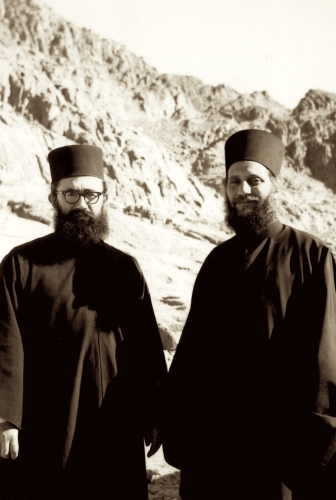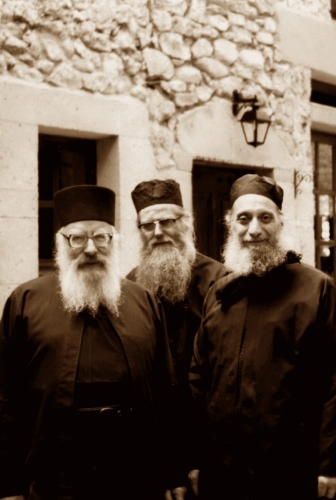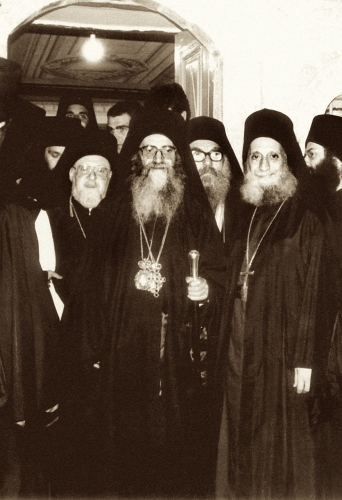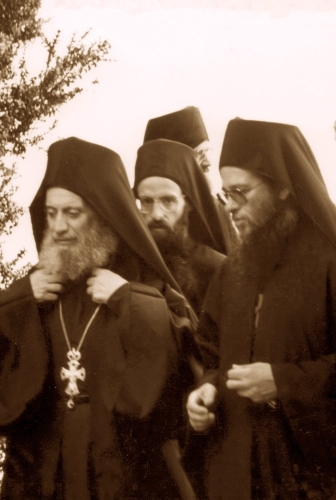Elder Aimilianos
TRACING A LIFE
SYNAXIS EUCHARISTIAS [A TOKEN OF GRATITUDE], by Brother Serapion of Simonopetra, to honour Elder Aimilianos, Indictos 2003
Archimandrite Elder Aimilianos, born Alexandros Vafeidis, Father Superior of Simonopetra from 1973 to 2000, was born in 1934, to pious parents, in Nikaia, Piraeus. The family originated from Asia Minor: His paternal grandmother, Evdoxia, was from Constantinople, and his grandfather, Alexandros, from Selymbria (present-day Silivri), in Thrace, studied in the famous Theological Seminary of Chalki Island (present-day Gökçeada).
In 1906 his grandparents moved to Semantra, in Cappadocia, where they served as teachers for the Greek community; they came to Greece after the Greco-Turkish War (1919–1922)/Asia Minor Massacre and the exchange of populations. Although married, they led an austere life of abstinence and prayer. It should be noted that both Aimilianos’ grandmother and mother became nuns and died as sister Eftaxia and sister Aimilani, respectively.
Elder Aimilianos attended primary school at Semantra, Halkidiki, where his grandmother had settled, and secondary school at Nikaia, in Piraeus, where his parents lived; he was always an excellent student. He continued his studies at the University of Athens; he initially attended Law School for two years and continued with Theology, to receive the education his calling sought.
During his university studies, as a member of a peer group with the same ideology and convictions since their secondary school years, he was extremely active in organising Sunday schools, speeches and various events, which promoted his mental, spiritual, leadership and organisational talents. When he completed his studies, and due to the education and training offered at the time, he considered becoming a priest so that he could go on to become a missionary abroad. However, he thought it would be best to start his preparation for such a goal at a monastery. He approached the then Metropolitan of Trikki (present-day Trikala) and Stages, Dionysios, who had just undertaken his priestly duties and was known as a bishop who supported monasticism.
The young man arrived at Trikala in 1960 and placed his future at the Metropolitan’s hands, took his vows in front of Metropolitan Dionysios on 9 December 1960 and was given the name Aimilianos as a monk at the Varlaam Monastery of Meteora. He was registered as a monk in the registry of the Monastery of St. Bessarion (Dousikou). On the 11th of the same month, the most reverend Metropolitan ordained him a deacon for the church of St. Paraskevi in Trikala; from then on, Elder Aimilianos was sent to various Meteora monasteries, which then had a shortage of monks, until he was ordained a priest at the Monastery of Vytoumas on the day of the Assumption in the year 1961.
After he was ordained a presbyter, he moved to the Monastery of St. Bessarion (Dousikou) where he stayed from four months, until December of the same year. At that remote and isolated place, he lived all alone in silence, painfully and extensively seeking God, “he who redeems from storms and failing spirit”. The Lord, in his prudence, listened to Elder Aimilianos’ silent cries, appeared to his servant and transformed his existence in His light, revealing ‘life paths’ to him.
Aimilianos now dedicated all his entire strength and enthusiasm to ascetic life and through this austerity envisaged with exceptional courage and heightened hope how to revive and renovate monastic communities.
At the end of 1961, given that the Metropolitan of Trikki shared the same dedication for ascetic life, invited Elder Aimilianos back from St. Bessarion and appointed him Father Superior at the Transfiguration Monastery of Megalo Meteoron. It was there, all alone at first, where, despite his fragile health, Aimilianos fortified himself with long-lasting patience, and indefatigably cultivated asceticism, leading a mystical and secluded life. He stayed vigilant, prayed continuously and delved in unceasing studying of paternal, ascetic and ecclesiastical works. His unquenchable thirst led him to seek, find and investigate every text referring to the organisation and operation of Eastern Orthodox monastic life, particularly that of a Coenobium, thoroughly exploring the monastic institutions of the Eastern Orthodox Church and the Typicon[the Rules] of distinguished ancient monasteries.
While Aimilianos led a purely ascetic life, on 1 January 1962, the Metropolitan bestowed on him the title of Archimandrite and assigned him the ministerial sermon task, as well as those of the confessions and education of the young in his province, appointing him in charge of the church of Panagia Episkepseos in Trikala.
This opened a new chapter in the life of the reverend Elder. He was not alone anymore: he became a ‘father’ to numerous ‘sons and daughters of God’; he lived as and felt like a true apostle. His life was dedicated to his children in full freedom, without any expectations even to the end, for even the slightest reciprocation or response. Many of these ‘children’ considered a monastic life. In time, the initial nucleus of the brotherhood of the Monastery of Meteoron was created, while others turned to a life of priesthood or family; whatever their choice, they remained a broader family-in-spirit, centred around the monastery.
In 1963 the first two monks settled at Megalo Meteoron; since the 1965-66 School year, numerous secondary school pupils conducted themselves as novices of the Elder. On 6 August 1966 Elder Aimilianos tonsured a’Megaloschemos’ Monk [Great Schema] before Metropolitan Dionysios, his own Elder; he had reached the highest rank of Eastern Orthodox Christian Monasticism. The life of the Meteoron and the course of his young, yet talented, son offered pure joy to the heart of His reverence and filled it with hopes for positive prospects. When monastic life was being established at Meteora, Elder Aimilianos consulted and forged spiritual bonds with pious contemporaries, such as: Athanasios Hamakiotis, Father [Papa-] Dimitris Gagastathis, Amphilochios of Patmos, Philotheos Zervakos, Simon Arvanitis, Damaskinos Katrakoulis. During the same period, Elder Aimilianos forged bonds with eminent members of the Serbian clergy and students at the University of Athens at the time, spiritual children of the holy Elder and pillar of the Serbian Church,Saint Justin Popović [Јустин Поповић], whomAimilianos visited in Serbia (1976), having become the Father Superior of Simonopetra Monastery. At the same time, the Elder launched his pilgrimage trips to Mt. Athos, where he collected a wealth of spiritual experience. It was then that Elder Aimilianos became acquainted with holy Father Paisios; on reaching the land’s end of the peninsula, he met the champion of obedience, Father [Papa] Ephraim Katounakiotis. The two men built a strong spiritual relationship, and Father [Papa] Ephraim often said: “I found my late Elder, another Elder Joseph, golden-tongued and reverend, Elder Aimilianos.”
In 1968, after his then young subordinates had taken their vows, the Meteoron brotherhood was created and, with his deep prudence -or, rather, foresight-Aimilianos laid the foundations of life in a coenobium. Elder Aimilianos’ insight immediately led him to select and accept as his successor the then secondary school pupil, Emmanuel Raptis, present-day Father Superior of our Convent, the very reverend Archimandrite Elissaios. In 1972, after a long trying period of difficulties, the initial nucleus of the monastic sisterhood was ready, led by its present-day Mother Superior, AbbessNicodeme; they were temporarily housed at the Monastery of Agioi Theodoroi, near Meteora. While the sisterhood was still in its early days, the wise Elder prepared its internal Regulation, his spiritual will and testimony and the only text he authored; this was delivered to the sisters on 5 May 1975, after they had already settled at the Metochion, i.e., the present-day Dependency.
Following the unexpected repose of the late Metropolitan Dionysios in January 1970, and because of the need to safeguard a quieter and more suitable monastic place for the brotherhood, away from noise and tourism, as well as the persistent request by Simonopetra monastery, with its dwindling members, at the end of 1973, the Meteoron brotherhood was ‘transplanted’ to Holy Mount Athos. The Father Superior’s office had remained vacant, following the late Archimandrite Charalambos’ repose, until, on 25 November 1973, Elder Aimilianos was elected by the senior brothers of the Monastery -in accordance to Mt. Athos traditions- to become the Father Superior of the Monastery, and was seated on the ‘throne’ of the Holy Community on 17 December.
The reverend Elder together with his vigilant life, the Holy Liturgy and all his other duties, undertook the reorganisation of the internal life of the new brotherhood. He embraces the existing Typicon [Rules] of Mt. Athos traditions with wisdom and discretion and also places his personal ‘stamp’ -in line with the divine Canon [Rules] compiled by the holy Fathers, whom he so adored and brought back to light thanks to his own burning thirst and labour- by creating the ‘Typicon’ [Rules] of the Monastery. Elder Aimilianos, respectfully and lovingly, injects the older monks’ experience with the youthful enthusiasm, dedication and zeal of the younger monks, increasing significantly the members of the brotherhood. With his virtuous administration and his pastoral ministerial care, he restored the prestige and highlighted the long tradition of this century-old Monastery.
After his entourage was settled at Mt. Athos, his ministries were also turned to the sisterhood that had joined the monastic community at Ormylia, Halkidiki on 5 July 1974, at the old Vatopedi Dependency of the Annunciation, which had been bought by Simonopetra Monastery. With the approval of the local Bishop and the support of the Holy Community, this Dependency was established and has been operating as the monastery Metochion ever since.
Hard labour and great efforts were necessary to renovate this small, ruined dependency, of which he became the wise and magnanimous founder, as he had to start from point zero. Having ensured the necessary peace and quiet in the area surrounding the Dependency, he launched the reconstruction of the buildings in 1980, “with God’s good will and grace”, as well as the contribution of the faithful; the result was the creation of was this major Coenobium within fifteen years. Elder Aimilianos was joyful and deeply moved when the Katholikon of the Metocheion was founded, on 14 September 1980, by Synesios, the Metropolitan of Kassandreia, whom he knew to be a discrete and judicious Bishop. On 25 October 1991, the Dependency received Patriarchical and Stavropegial recognition, by virtue of an Epistle bearing the Partriarchal sigillum of his divine All Holiness Ecumenical Patriarch Bartholomew.
Following the example of the Fathers, who helped their needy and sick fellows, in 1982, Aimilianos founded the spiritual and social support Centre ‘Panagia Philanthropini’, near the Dependency. The centre was the legacy of the late Captain Ioannis Hatzipateras and operates under the supervision and with the care of the sisterhood, providing humbly without any profit for the people of the vicinity.
The Elder considered all its Dependencies as part of Simonopetra Monastery, namely: The Church of the Ascension in Athens, the Church of St. Charalambos in Thessaloniki, the Church of St. Nicodemus in Pentalofos, Goumenissa, and St. Antoniοs Monastery and the two Convents, namely of the Transfiguration and of Monastère de la Protection-de-la-Mère-de-Dieu / Agia Skepi in France. Elder Aimilianos looked after and tenderly and carefully supported all of them, because they are frequented by many who find the Church truly close to them.
He showed special care and concern for all those of other faiths who sought him out and he was involved in the catechism of many of them, whom he later baptised and tonsured. Among them stand out Archimandrite FatherPlacide Deseille and Father Elias Ragot, with their entourages. In the period 1979-1984, these entourages created three Simonopetra dependencies in France, under the guidance and with the support of the Elder. These are: The Monastery of St. Antonios and two Convents, that of Monastère de la Protection-de-la-Mère-de-Dieu / Agia Skepi and that of the Transfiguration, which are incubators of Eastern Orthodox monasticism in the West.
As of 1980, Elder Aimilianos often visited the Dependencies in France to guide and strengthen the new brotherhood and sisterhoods. At the same time, he also visited the late Father Sophrony, at the Monastery of St. John the Baptist in Essex, England; the two men were bonded through a loving and deeply spiritual relationship. In fact, in the year 1988, the Elder attended the ceremonies of sanctification of St. Silouan the Athonite and the opening of the Church dedicated to the Saint, while in 1993, shortly before Father Sophrony’s repose, Elder Aimilianos accepted his invitation to bless his final abode in the newly constructed crypt. In his capacity as Father Superior, Elder Aimilianos participated in Mt. Athos affairs, the meetings of its supreme institutional bodies, namely, the Biannual Holy Assembly and the Extraordinary Double Holy Assembly, at which he readily contributed to the resolution of numerous Athonian affairs, thanks to his experience and discretion. He also represented Mt. Athos Community before the Ecumenical Patriarchate, the Hellenic Republic and elsewhere, as a member of Holy Community Committees and as a mission delegate [Exarchos].
Mainly working as the spiritual father of his Monastery and of the sisterhood of the Ormylia Dependency (Metochion), he dedicated most of his time spreading the news of this ministry as well as leading his own monastic life in his deeply sought isolation and peace. However, his love for God’s people and the Church occasionally led him to respond to invitations by higher members of the clergy, at various locations, or by other bodies, to deliver a speech or to participate in theological-monastic conferences in Greece, Cyprus and elsewhere, to educate his brothers and sisters in Christ.
Placing always the Lord before him, he faced any difficulty in a most natural, calm and joyful manner, accepting everything as part of divine blessing. This was his disposition when he faced the major fire of August 1990, which burnt throughout Mt. Athos and seriously threatened our Monastery.
In the beginning of 1995, his health was permanently affected and this obliged the reverend Elder to gradually withdraw from his fatherly duties and leave the monastery he cherished and his beloved Mt. Athos. In the year 2000, the reverend Father handed over the reins of his office to present-day Father Superior of Simonopetra, the All Holy Archimandrite Elissaios, who continues Elder Aimilianos’ work in filial respect. Elder Aimilianos withdrew to the Ormylia Dependency, “completing in his flesh what is still lacking in regard to Christ’s afflictions, for the sake of His body, that is the Church”, patiently and stoically.
Very few texts from the wealth of the Elder’s spiritual work saw the light of publicity during his active days, because his main mission was to train his spiritual children or the Church congregation and help them grow in spirit, thus humbly avoiding any publication.
The words of Elder Aimilianos are characterised by an experiential approach to any issue, by deep analysis of concepts and a spontaneous manner of expression. His catechism work is his precious legacy, bequeathed to his brothers; like a chalice full of “undiluted wine”, which, in endless silence has become “adorned with gold and silver”,it is preserved by the brotherhood and sisterhood as a precious relic and flows to God’s Church in the form of pastoral love.
The Sisterhood at Ormylia Dependency Convent has undertaken to transcribe Elder Aimilianos’ numerous catechisms and speeches with a view to publishing them.
The Elder’s term in office at Simonopetra has already been recognised as one of the most blessed periods of the modern history of the Monastery, making it duly proud, and, by the blessing of the Theotokos, together with the wider monastic community and the light of the Holy Mountain. As the Elder himself says “The monastic sodality of the Coenobium, leading life at its own pace, in essence lives within and for the Church, being what the heart or an extremity is for the body. What makes such a community appreciated is not its activities, but, mainly, its loving quest for God. This is how monks become God-like, attracting others to the divine life” (Typikon of Ormylia Holy Coenobium).
On 9 May 2019, Elder Aimilianos reposed in the Lord, at the Dependency [Metochion] of Ormylia. His relics lie in the founder’s [Ktitor‘s] tomb, in the external narthex of the Katholikon of the Dependency.
